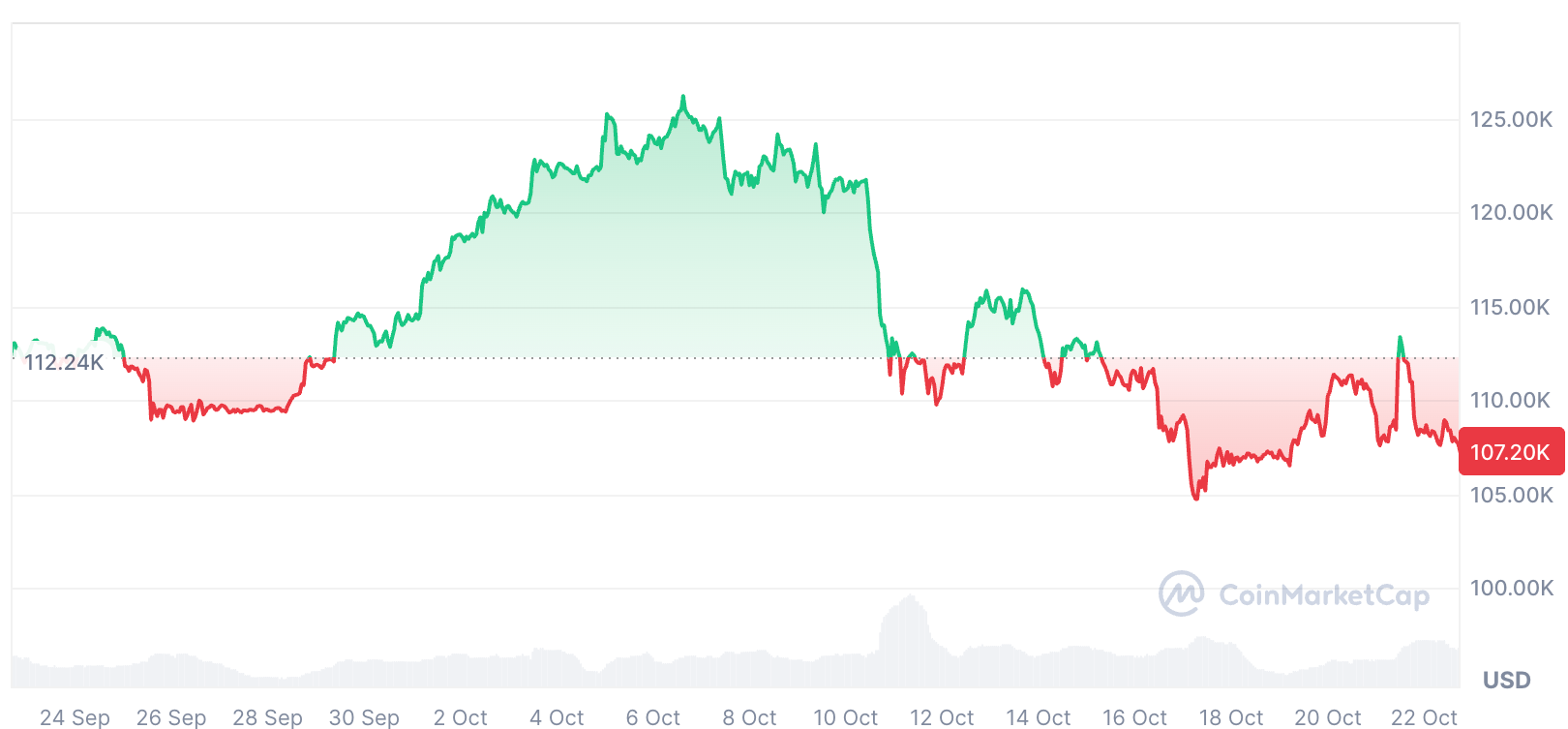Bitcoin ETF outflows totaling $1.23 billion between October 13 and 17 have heightened risks to the $107,000-$108,000 support level, warn Bitfinex analysts, due to absent institutional buying amid broader market pressures from tariff announcements.
-
Net outflows from spot Bitcoin ETFs signal demand-side fragility without sustained inflows.
-
Bitcoin’s price has retraced below $110,000 after a brief surge, trading around $108,864.
-
Analysts predict prolonged consolidation if ETF flows do not recover, with data from Farside showing $1.23 billion in outflows over five days.
Bitcoin ETF outflows threaten price stability: Discover how $1.23B net exits expose support levels and what it means for BTC amid 2025 market dynamics. Stay informed on crypto trends—read now!
What Are the Impacts of Bitcoin ETF Outflows on Price Support?
Bitcoin ETF outflows pose significant risks to the cryptocurrency’s price stability, particularly around the $107,000 to $108,000 support zone, as highlighted by Bitfinex analysts. These outflows, amounting to approximately $1.23 billion between October 13 and 17, reflect a lack of institutional accumulation following U.S. President Donald Trump’s tariff announcement. Without renewed inflows, Bitcoin could enter a phase of prolonged consolidation, undermining previous rally drivers.
How Have Recent Bitcoin ETF Flows Influenced Market Sentiment?
Recent data from Farside indicates that spot Bitcoin ETFs experienced substantial net outflows, underscoring the absence of meaningful dip-buying from institutional investors, according to Bitfinex analysts in their Tuesday report. This trend persisted through two of three trading days this week, though Tuesday’s strong inflows resulted in overall positive net flows of $335.4 million. Bitcoin, currently trading at $108,864 per CoinMarketCap data, briefly exceeded $113,000 earlier in the week before retracing, mirroring broader financial market volatility.
The analysts emphasize that the $107,000 to $108,000 zone is increasingly difficult to defend without institutional support. They note that Bitcoin’s price action could serve as a warning signal for extended sideways movement if weakness continues. In their assessment, persistent ETF outflow trends point to growing demand-side fragility, potentially eroding the consistent accumulation that fueled prior price surges.
Supporting this view, Bitfinex’s report highlights how external factors, such as the tariff announcement, have contributed to the red ink in ETF performance. Over the past 30 days, Bitcoin has declined 3.36%, as shown in market tracking from CoinMarketCap. This decline aligns with the broader crypto market crash, amplifying concerns over support levels.
Experts like Galaxy Digital CEO Mike Novogratz have tempered overly optimistic forecasts, stating that reaching $250,000 by year-end would require extraordinary developments. In a worst-case outlook, he maintains Bitcoin should hold above $100,000 this year. Meanwhile, predictions from BitMEX co-founder Arthur Hayes and BitMine chair Tom Lee remain bullish, eyeing $250,000 potential despite current headwinds.
Bitfinex analysts further explain that if ETF inflows fail to recover meaningfully in the coming weeks, it could heighten risks of a more drawn-out consolidation phase. This scenario would challenge one of the key pillars behind Bitcoin’s recent rallies: steady institutional participation. The report’s data-driven insights demonstrate the interplay between ETF flows and price dynamics, offering a clear picture of current market pressures.
To illustrate the severity, consider the $1.23 billion outflow figure from Farside, which captures a critical five-day period. This volume of exits not only pressured immediate price levels but also signaled broader investor caution. Institutional investors, typically a stabilizing force, have been notably absent, leaving retail and other participants to navigate the volatility.
Market participants continue to debate the trajectory, with consensus leaning toward an eventual upswing by year-end. However, the immediate focus remains on ETF performance as a barometer for institutional confidence. Bitfinex’s analysis serves as a authoritative reminder of the vulnerabilities exposed by these outflows, drawing on real-time data to inform investor strategies.

Bitcoin is down 3.36% over the past 30 days. Source: CoinMarketCap
The Bitfinex analysts said the data “underscores the current absence of meaningful dip-buying from institutional investors.”
Frequently Asked Questions
What Caused the Recent $1.23 Billion Bitcoin ETF Outflows?
The outflows from October 13 to 17 stemmed primarily from the crypto market crash following U.S. President Donald Trump’s tariff announcement, leading to reduced institutional buying. Farside data confirms this $1.23 billion net exit, highlighting a defensive posture among investors amid heightened uncertainty.
Will Bitcoin Hold Its $107,000 Support Level Amid ETF Weakness?
Bitcoin’s ability to maintain the $107,000 to $108,000 support depends on recovering ETF inflows; without them, Bitfinex warns of demand-side fragility and potential prolonged consolidation. Trading around $108,864 now, a break below could signal broader market caution, though experts like Mike Novogratz see $100,000 as a firm floor for 2025.
Key Takeaways
- ETF Outflows Signal Fragility: The $1.23 billion net exits from spot Bitcoin ETFs indicate weak institutional demand, pressuring the $107,000-$108,000 support zone as per Bitfinex analysis.
- Price Retracement Reflects Market Volatility: Bitcoin’s drop from $113,000 to $108,864 mirrors financial market trends, with 3.36% decline over 30 days underscoring the need for inflow recovery.
- Year-End Outlook Remains Mixed: While Hayes and Lee predict $250,000 potential, Novogratz cautions on extraordinary factors needed, advising vigilance on ETF flows for sustained momentum.
Conclusion
In summary, Bitcoin ETF outflows have exposed vulnerabilities in price support levels, with the $1.23 billion net exits amplifying demand-side risks as detailed by Bitfinex analysts. Recent flows and market data from sources like Farside and CoinMarketCap illustrate the critical role of institutional accumulation in maintaining stability. As 2025 progresses, monitoring ETF performance will be essential; investors should prepare for possible consolidation while eyeing potential recoveries that could drive Bitcoin toward higher targets by year-end.
